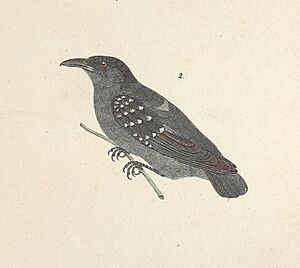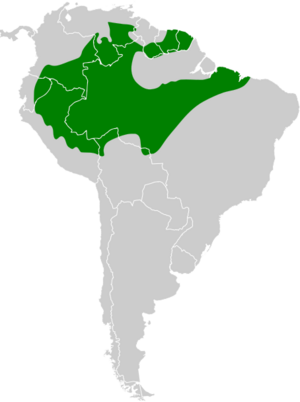Spot-winged antshrike facts for kids
Quick facts for kids Spot-winged antshrike |
|
|---|---|
 |
|
| Illustration in Avium Species Novae by Johann Baptist von Spix | |
| Conservation status | |
| Scientific classification | |
| Genus: |
Pygiptila
|
| Species: |
stellaris
|
 |
|
The spot-winged antshrike (Pygiptila stellaris) is a small bird that lives in the forests of South America. It belongs to a group of birds called "typical antbirds." You can find it in countries like Bolivia, Brazil, Colombia, Ecuador, Guyana, Peru, Suriname, and Venezuela. It might also live in French Guiana.
Contents
About the Spot-winged Antshrike
How Scientists Name Birds
The spot-winged antshrike was first described and drawn by a German scientist named Johann Baptist Ritter von Spix in 1825. He gave it the scientific name Thamnophilus stellaris. Later, in 1858, another scientist, Philip Sclater, created the group Pygiptila just for this bird. It's the only species in that group!
Scientists sometimes have different ideas about how to group animals. For the spot-winged antshrike, some groups of scientists recognize four slightly different types, or subspecies:
- P. s. maculipennis
- P. s. occipitalis
- P. s. purusiana
- P. s. stellaris
Other groups think there are only two main types. For this article, we'll talk about the four types.
What Does It Look Like?
The spot-winged antshrike is about 12 to 13.5 centimeters (5 inches) long. It weighs about 23 to 27 grams (less than an ounce). It has a short tail and a strong, thick beak.
Male and female antshrikes look quite different.
- Adult males are mostly gray. Their upper body is a bit darker, and they have a black top of the head. They also have some black feathers on their back and white spots on their wing feathers.
- Adult females are gray with a brownish-orange (clay) color on their head, upper body, and tail. Their face and belly are a pale brownish-orange. Their wing feathers are a cinnamon-brown color, and they do not have white spots on their wings like the males.
Where Does It Live?
The different types of spot-winged antshrikes live in various parts of South America:
- P. s. maculipennis lives in southeastern Colombia, eastern Ecuador, and central Peru.
- P. s. occipitalis is found in eastern Colombia, northern Venezuela, northern Brazil, and the Guianas.
- P. s. purusiana lives in southeastern Peru, northern Bolivia, and west-central Brazil.
- P. s. stellaris is found in Brazil, south of the Amazon River.
This bird mostly lives in lowland evergreen forests. These are forests that stay green all year. It can be found in both "terra firme" forests (which are not flooded) and forests that get flooded sometimes. It also lives in forests that are growing back after being cut down (secondary forest).
The spot-winged antshrike usually stays high up in the trees, from the middle branches to the very top. It can live at different heights above sea level, up to 700 meters (about 2,300 feet) in Brazil.
Behavior and Life Cycle
Movement
Scientists believe the spot-winged antshrike stays in the same area all year round. It doesn't migrate to other places.
What Does It Eat?
This bird mainly eats small insects and other creatures with many legs, called arthropods. Once, someone even saw it eating a frog!
It usually looks for food alone, in pairs, or in small family groups. It hops along branches and through leaves, typically between 7 and 25 meters (23 to 82 feet) above the ground. It seems to like finding food in tangled vines. It also often pokes and tears apart bunches of dead leaves to find hidden prey.
The spot-winged antshrike sometimes joins groups of different bird species that are feeding together. It also occasionally goes near swarms of army ants, where it can catch insects that are trying to escape the ants. When it does this, it goes closer to the ground.
Reproduction
Scientists don't know much about when the spot-winged antshrike breeds, but it seems to happen between September and November. Both the male and female birds work together to build a nest. They pile up leaves and plant fibers on tangled branches. Then, they sit on the pile to shape it into a nest. Not much else is known about how they raise their young.
What Does It Sound Like?
The spot-winged antshrike's song is a series of short, quick notes. These notes get louder and then drop slightly in pitch. Right after, there's a long whistle that usually rises and falls a little in pitch. People describe it as sounding like "tdrrrr Tiúw" or "t-t-t-t-t-t-teéuw." Its calls include a sharp sound like "'chet!" or "chak."
Conservation Status
The IUCN (International Union for Conservation of Nature) has looked at the spot-winged antshrike and decided it is a species of "Least Concern." This means it's not currently in danger of disappearing.
It lives in a very large area. Even though we don't know exactly how many of these birds there are, scientists believe their population is stable. There are no immediate threats to the species. It's considered common in most places where it lives and can be found in many protected areas. Its home also includes large, untouched forests that are not likely to be developed anytime soon.


